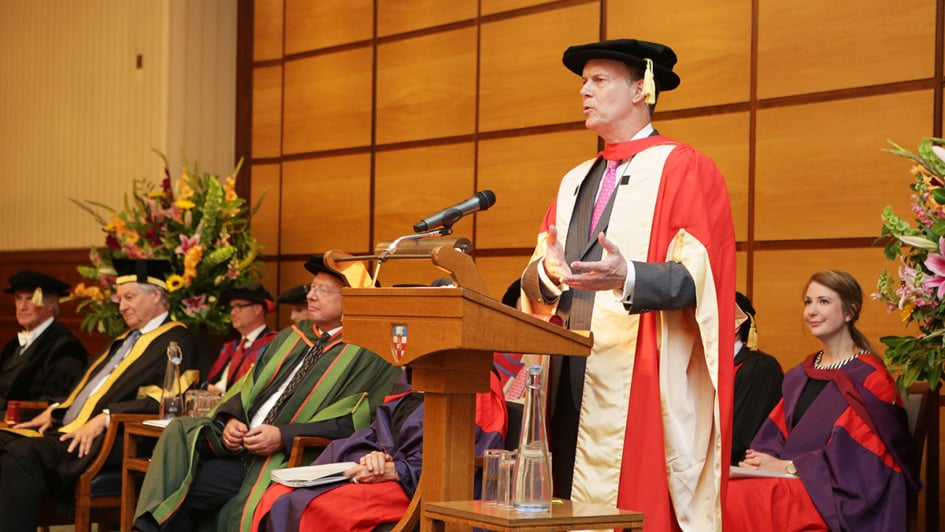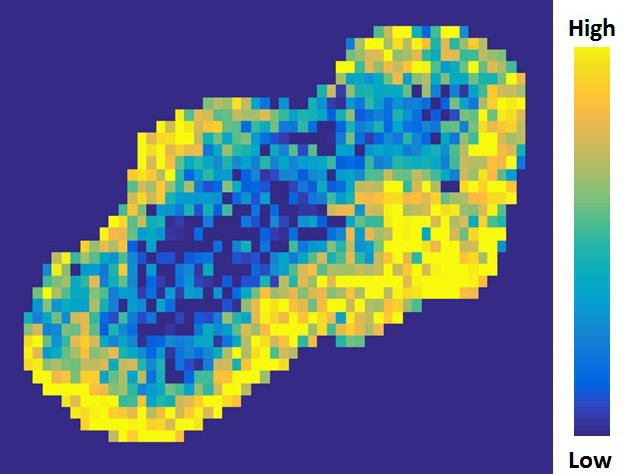
Image: William Kaelin receiving his honorary doctorate from the ICR.
Every year, Nobel prizes recognise revolutionary advances and celebrate hugely impactful research. Last week, William Kaelin, Sir Peter Ratcliffe and Gregg Semenza received the 2019 Nobel Prize for Medicine, for their discoveries of how cells sense and adapt to oxygen availability.
The three winners successfully identified the molecular machinery responsible for regulating the activity of genes in response to fluctuating oxygen levels. As a consequence, their research has established the basis for our understanding of how cells sense oxygen and adapt in response to that, altering our cellular metabolism in the process.
Last year, one of the three laureates – Professor William Kaelin, from Harvard University and the Dana–Farber Cancer Institute – was awarded an honorary doctorate by the ICR, for his outstanding research into how cancer cells sense oxygen levels.
Oxygen sensing and cancer
How are the fundamental mechanisms of oxygen sensing related to cancer? Like normal cells, cancer cells need oxygen to survive. For this reason, cancer cells send out signals during a process called angiogenesis – which encourages the growth of new blood vessels into the tumour. These blood vessels carry oxygen and nutrients and allow the tumour to grow.
Hypoxia – when oxygen levels in a tissue are low – is a feature of cancer, and often indicates that cancer is growing aggressively. Hypoxia stimulates the growth of blood vessels within tumours, which can fuel the spread of cancer cells to other parts of the body.
The papers behind the Nobel Prize discovery – which were published over a decade ago – helped establish this understanding. Additionally, they showed that tumour-suppressor proteins like VHL can play a role in oxygen signalling.
It was actually Professor Kaelin who focused on studying Von Hippel-Lindau (VHL) syndrome – an inherited condition characterised by a mutated VHL gene that can lead to kidney cancer, amongst others. Ultimately, Professor Kaelin’s work on the VHL protein led to the successful clinical testing of drugs that block blood vessel growth to treat kidney cancer.
Oxygen sensing in the context of imaging techniques
At the ICR, researchers have used imaging techniques to detect and measure areas of low oxygen – known as hypoxia. A few years ago, for example, researchers from the Cancer Research UK Cancer Imaging Centre at the ICR used MRI techniques to help doctors predict survival by identifying areas of fluctuating oxygen levels in head and neck tumours.
Professor Jeffrey Bamber and the Ultrasound and Optical Imaging Team also showed that combining two advanced imaging techniques can help identify areas of low oxygen within tumours. This helps predict how effective radiation or drug treatments will be, and potentially enables the use of ultrasound to guide treatment of hypoxic tumours.
Additionally, Dr Simon Robinson, who is part of the Magnetic Resonance Team at the ICR, is also internationally recognised for his studies in the use of blood-oxygen-level-dependent (BOLD) MRI. This type of imaging can be used to observe activity in the brain and other organs – and can help predict treatment response in cancer patients.
From basic science to clinical benefit
These examples highlight how imaging oxygenation to map areas of low oxygen within tumours can be important for patient outcome. But most importantly, these examples demonstrate the importance of fundamental, early-stage research – known as basic science – which can lead to clinical benefits many years later.
In this way, the work of the three Nobel laureates and their teams has paved the way to a greater understanding of cancer, as well as promising new ways to treat it.
'An outstanding scientist and collaborator'
Professor Chris Lord is Deputy Head of Division and the leader of the Gene Function Team at the ICR. He has collaborated with one of the Laureates, Professor Kaelin. Commenting on the Nobel’s announcement, he said:
“Around a year ago, Bill and I collaborated in a study that looked at the interaction between AURKB – a protein involved in cell division – and the tumour suppressor RB1. We used CRISPR to show that tumour cells lacking the tumour suppressor RB1 were highly dependent on AURKB, likely because both genes have important roles in cell division. This suggested that AURKB inhibitors, which are now being used in clinical trials, could be used to target RB1 defective cancers.
“Having worked with Bill in the past, I am personally thrilled to hear the exciting news that he has jointly won this year’s Nobel Prize in Physiology or Medicine. Bill is an outstanding scientist and collaborator, and it is truly exciting to see his work getting the recognition it deserves.”
